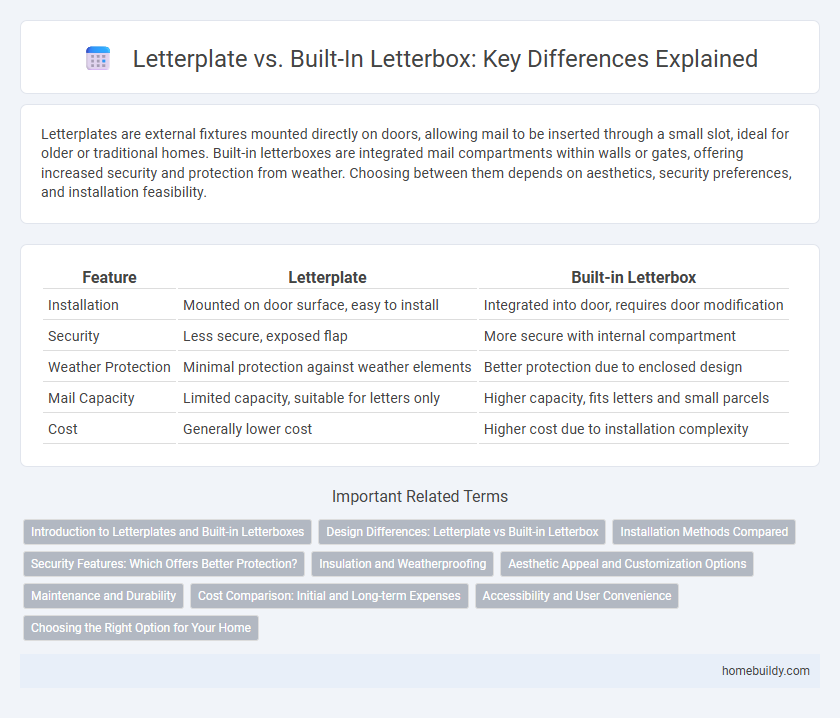Letterplates are external fixtures mounted directly on doors, allowing mail to be inserted through a small slot, ideal for older or traditional homes. Built-in letterboxes are integrated mail compartments within walls or gates, offering increased security and protection from weather. Choosing between them depends on aesthetics, security preferences, and installation feasibility.
Table of Comparison
| Feature | Letterplate | Built-in Letterbox |
|---|---|---|
| Installation | Mounted on door surface, easy to install | Integrated into door, requires door modification |
| Security | Less secure, exposed flap | More secure with internal compartment |
| Weather Protection | Minimal protection against weather elements | Better protection due to enclosed design |
| Mail Capacity | Limited capacity, suitable for letters only | Higher capacity, fits letters and small parcels |
| Cost | Generally lower cost | Higher cost due to installation complexity |
Introduction to Letterplates and Built-in Letterboxes
Letterplates and built-in letterboxes serve the essential purpose of mail delivery, with letterplates installed directly into doors while built-in letterboxes are integrated into walls or fences. Letterplates provide a compact, space-saving solution that maintains door aesthetics and usually feature a flap to protect against weather and drafts. Built-in letterboxes offer larger storage capacity and enhanced security, making them suitable for homes expecting higher mail volumes or parcels.
Design Differences: Letterplate vs Built-in Letterbox
Letterplates are surface-mounted units affixed directly onto doors, offering a sleek, visible design that can complement modern and traditional aesthetics. Built-in letterboxes are recessed into the door or wall, creating a flush, discreet appearance that enhances security and weather protection. Design choices between letterplates and built-in letterboxes impact overall door style, material integration, and space efficiency.
Installation Methods Compared
Surface-mounted letterplates offer straightforward installation by attaching directly to existing doors with screws, requiring minimal door modification. Built-in letterboxes demand precise measurements and door cutting to embed the mailbox, resulting in a more complex and time-intensive process. Choosing between these depends on whether ease of installation or a seamless aesthetic integration is prioritized.
Security Features: Which Offers Better Protection?
Letterplates typically provide a straightforward access point but are more vulnerable to mail theft and tampering due to their external placement and limited security features. Built-in letterboxes often incorporate lockable compartments and reinforced construction, offering enhanced protection against unauthorized access and weather damage. Security-conscious homeowners should prioritize built-in letterboxes for superior safeguarding of mail and sensitive information.
Insulation and Weatherproofing
Letterplates offer superior insulation and weatherproofing compared to built-in letterboxes due to their integrated design within the door, minimizing drafts and reducing heat loss. Built-in letterboxes often create gaps that allow cold air, dust, and moisture to penetrate, compromising indoor comfort and energy efficiency. High-quality letterplates feature durable seals and insulation materials that enhance thermal performance and protect against harsh weather conditions.
Aesthetic Appeal and Customization Options
Letterplates offer enhanced aesthetic appeal with customizable designs, finishes, and materials that seamlessly blend with various door styles, unlike built-in letterboxes which often have limited design options and appear more utilitarian. Customization options for letterplates include size, color, and decorative elements, allowing homeowners to create a personalized entryway feature. Built-in letterboxes typically prioritize functionality and security, sacrificing the flexibility for visual enhancement and unique styling.
Maintenance and Durability
Letterplates often require regular upkeep to prevent rust and ensure smooth flap operation, particularly when exposed to harsh weather. Built-in letterboxes tend to offer enhanced durability due to their recessed installation, which protects them from direct impact and environmental wear. Maintenance for built-in letterboxes typically involves less frequent repairs, resulting in a longer lifespan and lower long-term costs.
Cost Comparison: Initial and Long-term Expenses
Letterplates typically incur lower initial costs compared to built-in letterboxes, making them a budget-friendly choice for homeowners seeking quick installation. Built-in letterboxes, while more expensive upfront due to construction and integration expenses, often provide enhanced durability and security, potentially reducing maintenance and replacement costs over time. Evaluating long-term expenses, invested in a built-in letterbox can lead to better value through minimized repairs and improved property aesthetics.
Accessibility and User Convenience
Letterplates offer enhanced accessibility by being installed directly on the door at an ergonomic height, allowing users to easily deposit mail without bending or reaching awkwardly, unlike built-in letterboxes often positioned lower or integrated into walls. User convenience is improved with letterplates due to their straightforward design, which simplifies mail delivery and retrieval, reducing the risk of mail being lost or damaged in transit. This accessibility feature particularly benefits elderly or disabled individuals by facilitating effortless interaction with their mail system.
Choosing the Right Option for Your Home
Choosing between a Letterplate and a built-in Letterbox depends on your home's architectural style and security needs. Letterplates are sleek and discreet, ideal for modern doors with minimal exterior protrusion, while built-in Letterboxes offer more storage capacity and enhanced protection against weather and theft. Consider factors like door material, mail volume, and neighborhood safety to select the best option ensuring convenience and durability.
Letterplate vs Built-in Letterbox Infographic

 homebuildy.com
homebuildy.com